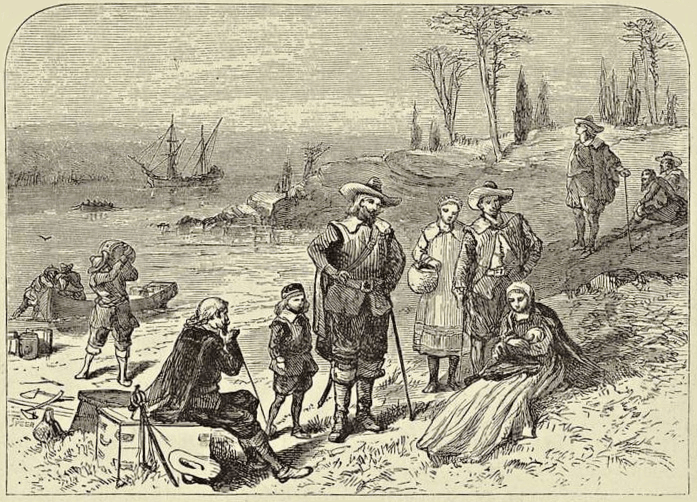
By MYRA VANDERPOOL GORMLEY
Copyright © 1988, 2006—All rights reserved.
Do not post or publish without written permission
It was French-speaking Walloons from Hainaut who were among the first to settle the Hudson River Valley and Manhattan Island between 1620 and 1626. Eight Belgian Protestant families, fleeing from Catholic Spanish religious persecution, joined the Dutch settlers in 1624 to settle what became New Amsterdam.
If your roots go back to the early settlements in New York, New Jersey, Connecticut, Delaware, Pennsylvania or the Middle Atlantic States you may have Walloons—people from the southern parts of Belgium—for ancestors. The fact that the Walloons sailed from Holland has caused many to believe, erroneously, that they were Dutch.
During the 16th Century when Luther and Calvin began preaching a new religion, thousands of Belgians became Protestants. But Belgium was governed by the Catholic rulers of Spain and persecuted Protestants, forcing many to flee. Many went to the northern parts of the Netherlands.
It was from their exile in Holland that they emigrated again—the first group came on the Nieu Netherlandt (New Netherland), and landed on Manhattan Island in 1623, under the auspices of the West India Company. Their ancestral homes were in what was called the Comte de Hainaut and the Comte de Flandre, from the cities of Avesnes, Valenciennes and Lille. Today, these cities are located in France, along its border with Belgium.
In early March of 1623, about 30 families, mostly Walloons, sailed on a 260-ton vessel, skippered by Cornelius Jacobs Mey. Their course was by the Canary Islands, when the ship was steered toward what was known as the “wild coast” (Guiana) where it picked up a west wind that brought these early settlers into the Hudson River—then called River Mauritius. A seven-to eight-week sailing time was about average for the crossing.
A list of the passengers of the Nieu Netherlandt, which numbered about 150, unfortunately does not exist. Or if it does, it has not been found yet. These first Belgian passengers, and those who arrived afterward during the Dutch administration, settled at Manhattan, Albany, Long Island, Staten Island, along the Connecticut and Delaware rivers; in New Jersey, Pennsylvania, Delaware, in the Hudson Valley, at Esopus, Wallkill, Kingston, Hurly, New Paltz and along the banks of the Wallonsac River.
Eight of those on the ship were left at Fort Amsterdam (now the lower part of Manhattan); four couples who were married at sea and eight men were sent to form a settlement on the South River, now the Delaware. They selected a spot on its east bank, near the present town of Gloucester, four miles below Camden, N. J. They called it “Fort Nassau.”
Two families and six men were sent to settle on the Connecticut River. They built a small fort, which became “Fort Good Hope.” It is on the site of the present city of Hartford, Conn. Eighteen families went up the Hudson River and landed near the spot where the city of Albany, N. Y., now stands.
Later Belgian Emigrants
Approximately 200,000 Belgians came to the United States between 1830 and 1975. These figures include both the Dutch-speaking Flemings of the northern provinces, generally known as Flanders, and the French-speaking Walloons of the southern provinces.
Between 1840 and 1884 there was a land shortage in Belgium and the Belgian government encouraged emigration, even to attempting a plan to send Flemish paupers to colonies in Algeria, Guatemala, Texas, Pennsylvania and Missouri.
The potato blight in the 1840s spurred the great exodus from the villages of Belgium to America. Most of these emigrants departed from the port of Antwerp and landed in New York. Port records of Antwerp show that before 1888 almost 80 percent of the Belgian emigrants came from rural provinces; after that date, less than 60 percent. Until the 1860s poor emigrants were subsidized by the Belgian government or were aided by the Midwestern land promoters and American labor recruiters.
Between 1850 and 1924 the majority of Belgian immigrants settled in states around Lake Michigan—Michigan, Illinois, Wisconsin and Indiana. Others went to Iowa, Pennsylvania, New York and Massachusetts. Those who came to America between 1900 and 1920, included many artisans, craftsmen and small entrepreneurs, as well as semi-skilled and skill craftsmen in the building trades and allied occupations.
Through the centuries our Belgian ancestors have brought many skills to America, which have been used in pottery, goldsmith arts, tapestry weaving, glass, rug and leather making, house furnishings, wood and stone carving, diamond cutting, cutlery, textile industry and metallurgy.
Bayer, Henry G., The Belgians: First Settlers in New York and in the Middle States. Bowie, Md.: Heritage Books, Inc., 1925, facsimile reprint edition 1987.
McEvedy, Colin, The Penguin Atlas of Modern History (to 1815). Penguin Books, n. p., 1972.
Robbins, Albert, Coming to America: Immigrants from Northern Europe. New York: Dell Publishing Co., Inc., 1982.
Thernstrom, Stephan, ed., Harvard Encyclopedia of American Ethnic Groups. Cambridge, Mass., and London, England: University Press, 1980.
